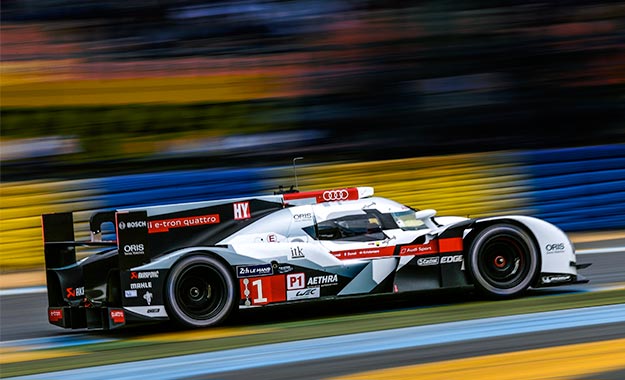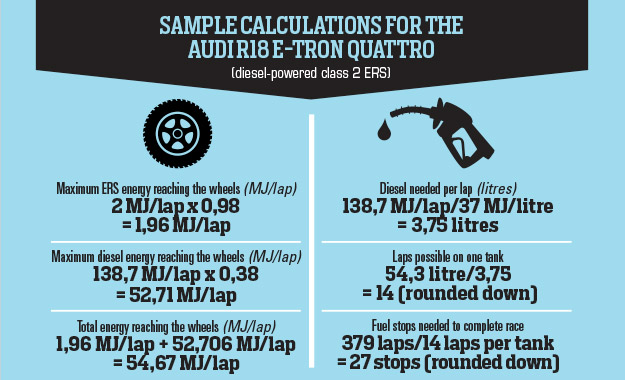In motorsport, efficiency has become as important as outright speed. We attended the 24 Hours of Le Mans to investigate the impact of the new LMP1 regulations on Audi’s challenge
“Save fuel” is not a message a racing driver wants to hear. Both Formula One and the World Endurance Championship (WEC), which includes the famous Le Mans race, had drastic regulatory changes this year aimed at upping efficiency. Teams have been pressured to carefully consider the use of available chemical and kinetic energy in order to have the fastest cars on the track. Having a quick driver isn’t enough anymore.
A manufacturer that has unequivocally shown this is possible is Audi. It was victorious at Le Mans for a 13th time in the Prototype One (LMP1) class, but not before making its car 22% more efficient than last year and without sacrificing speed. In this feature I’ll use Audi as an example to explain the impact of energy regulations.
Background
This year marked the 82nd running of Le Mans. One of the reasons why it’s so special is because the regulations have always promoted innovation and have given engineers free rein within set boundaries to experiment with different technologies. This approach led to three manufacturers competing in the LMP1 class this year.
They used vastly different powertrains but achieved comparable lap times.
AUDI |
TOYOTA |
PORSCHE |
|
|---|---|---|---|
| Engine | |||
| Location | mid-mounted | mid-mounted | mid-mounted |
| Fuel Supply | common-rail, direct injection, turbocharged, intercooled, diesel | electronicfuel injection, petrol | electronic, direct fuel injection, turbocharged, intercooled |
| Cylinders | V6, longitudinal | V8, longitudinal | V4, longitudinal |
| Cubic Capacity | 4,0 litres | 3,7 litres | 2,0 litres |
| Approx. Output (kW/N.m) | 395/800 | 383/- | 370/- |
| Energy-Recovery System | |||
| Location | front axle | front and rear axle | front axle and turbo |
| Power Unit | electric motor/generator | electric motors/generators | electric motor/generator (front axle) andgenerator (turbo) |
| Maximum Output (kW) | 170 | 354 | 185 |
| Energy Storage | fly-wheel accumulator | super-capacitors | lithium-ion batteries |
| Energy Class (MJ/Lap) | 2 | 6 | 6 |
| Fastest Lap at Le Mans 2014 | 3:22,567 | 3:23,112 | 3:24,899 |
Efficiency Regulations
The reason that the cars achieved almost identical lap times despite their obvious powertrain differences points to a successful performance balance in the regulations. In the past (and currently in many other formulas), an air restrictor in the intake limited the amount of air that an engine could breathe and this in turn limited the amount of fuel that could be burned. This setup is acceptable in a racing formula that uses naturally aspirated petrol engines, but gets complicated with the mix of petrol/diesel and naturally aspirated/turbo engines of today.
The governing body, International Automobile Federation (FIA), has chosen to concentrate on limiting the chemical (fuel) energy and kinetic energy release (recovered mostly under braking) of the vehicles. This has allowed the individual teams freedom to develop unique powertrains within the boundaries stipulated in the table below. Each team needed to choose an energy class before the start of the season with class zero denoting no energy release from the energy recovery system (ERS), up to class eight that allows up to 8 MJ of energy release per lap.
Values of energies and power for Le Mans |
|||||
|---|---|---|---|---|---|
| ERS class | 0 | 2 | 4 | 6 | 8 |
| Max ERS energy release (MJ/lap) | 0 | <2 | <4 | <6 | <8 |
| Min vehicle mass (kg) | 850 | 870 | 870 | 870 | 870 |
| Max petrol energy (MJ/lap) | 157,2 | 147 | 143,3 | 139,5 | 138 |
| Max petrol flow rate (kg/h) | 100,9 | 94,3 | 91,9 | 89,5 | 88,5 |
| Max petrol fuel-tank capacity (L) | 68,3 | 68,3 | 68,3 | 68,3 | 68,3 |
| Max diesel energy (MJ/lap) | 146,4 | 138,7 | 135,2 | 131,7 | 128,5 |
| Max diesel flow rate (kg/h) | 84,6 | 80,2 | 78,2 | 76,1 | 74,3 |
Discussion
The theoretical lap time of each ERS class of vehicle in the petrol and diesel group is linked to the total energy available per lap (ignoring aerodynamics, vehicle setup and driver skill). Looking at the diesel group, it’s clear that ERS group eight should deliver the fastest lap time, as 56,67 MJ/lap is the highest value. Audi could unfortunately opt only for group two with a total of 54,67 MJ/lap owing to the mass restriction of the vehicle and heavy diesel powertrain. It may appear that Audi would have been better off to opt for the zero ERS class because the total energy available per lap would have been 55,63 MJ/lap. This is misleading, however, as the higher fuel consumption with the same size fuel tank would have resulted in at least two extra pit stops over the race distance (more than a minute is lost per pit stop). The winning Audi stopped 29 times during the race.
Comparing the total available energy of the Audi (54,67MJ/ lap) with those of the Toyota and Porsche (54,71 MJ/ Lap), both of which chose class six ERS petrol powertrains, it is clear why the fastest lap times were so close (again ignoring aerodynamics, vehicle setup and driver skill). It appears that the allowable tank size of the diesel vehicles was too small, as the Audi theoretically would have had to make five extra pit stops to complete the race.
In the end, durability played the biggest role and the Audi technicians were able to fix the issues in the shortest time and send the two vehicles out to win the race (the third Audi was involved in a crash).
Values of energies and power for Le Mans |
|||||
|---|---|---|---|---|---|
| ERS class | 0 | 2 | 4 | 6 | 8 |
| Max ERS energy release (MJ/lap) | 0 | 2 | 4 | 6 | 8 |
| Max ERS energy reaching the wheels (MJ/lap) | 0 | 1,96 | 3,92 | 5,88 | 7,84 |
| Max petrol energy (MJ/lap) | 157,2 | 147 | 143,3 | 139,5 | 138 |
| Max petrol energy reaching the wheels (MJ/lap) | 55,02 | 51,45 | 50,155 | 48,825 | 48,3 |
| Max petrol engine power calculated (kW) | 455,17 | 425,40 | 414,57 | 403,74 | 399,23 |
| Total energy reaching the wheels (MJ/lap) | 55,02 | 51,45 | 50,155 | 48,825 | 48,3 |
| Petrol needed per lap (L) | 4,62 | 4,32 | 4,21 | 4,10 | 4,06 |
| Laps possible on one tank | 14 | 15 | 16 | 16 | 16 |
| Fuel stops needed to complete race | 27 | 25 | 23 | 23 | 23 |
| The FIA monitors all energy flow of racecars in real time throughout the race |
|||||
Values of energies and power for Le Mans |
|||||
| ERS class | 0 | 2 | 4 | 6 | 8 |
| Max ERS energy release (MJ/lap) | 0 | 2 | 4 | 6 | 8 |
| Max ERS energy reaching the wheels (MJ/lap) | 0 | 1,96 | 3,92 | 5,88 | 7,84 |
| Max petrol energy (MJ/lap) | 146,4 | 138,7 | 135,2 | 131,7 | 128,5 |
| Max petrol energy reaching the wheels (MJ/lap) | 55,632 | 52,71 | 51,376 | 50,046 | 48,83 |
| Max petrol engine power calculated (kW) | 412,57 | 391,11 | 381,36 | 371,11 | 362,34 |
| Total energy reaching the wheels (MJ/lap) | 55,63 | 54,67 | 55,30 | 55,93 | 56,67 |
| Petrol needed per lap (L) | 3,96 | 3,75 | 3,65 | 3,56 | 3,47 |
| Laps possible on one tank | 13 | 14 | 14 | 15 | 15 |
| Fuel stops needed to complete race | 29 | 27 | 27 | 25 | 25 |
| The FIA monitors all energy flow of racecars in real time throughout the race | |||||
Summary
Efficiency regulations have forced carmakers to use innovative technologies to make the best possible use of the chemical (fuel) and kinetic (motion) energy available to the racecar. These breakthroughs in motor-sport should filter down to production cars, to everyone’s benefit.








